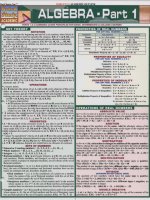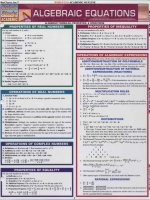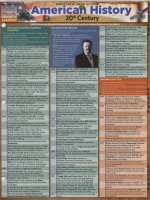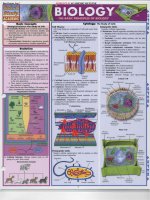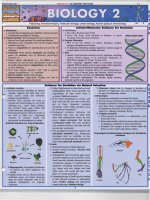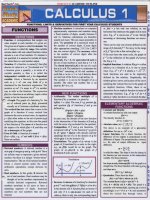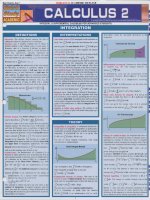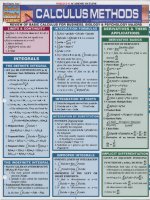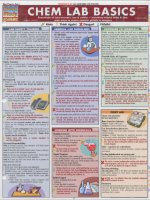Quick study academic biology 1 600dpi
Bạn đang xem bản rút gọn của tài liệu. Xem và tải ngay bản đầy đủ của tài liệu tại đây (8.04 MB, 4 trang )
~
=
~~~~~~
~~~~~~~~~~~~~
~
Basic Concepts
m
Biological Science: The Study of Life
Cell Theory:
Eukaryotic Cells:
Z
A. The Scientific Method: How scientists study biology
I. Observe phenomena and formulate testable and
fal s ifiable (in case they are wrong) hypotheses
2. Test hypotheses, collect data, and analyze statisti
cally (if necessary)
B. What is life')
1. Characteristics: Metabolism, reproduction, growth,
movement, responsiveness, complex organization
All living things are composed of cell s and come from
cells
A. Cell Size: Small to maximi ze surface area to volume
ratio for regulating internal cell environment
B. Cell (Plasma) Membrane: Composed of fluid-like phos
pholipid bilayer, proteins, cholesterol and glycoproteins
Cell (Plasma) Membrane
Evolution
Concept that all organisms are rel ated to each other by
common ancestry: The unifying theme in biology
A. Natural Selection: A mechani sm for thc occurrence
of evoluti on
I. Survival of those offspring best adapted to the
condition s in whieh they live:
3. Individuals produce sexually many morc ofl~
spring than could poss ibly survive
b. These otfspring are not identical (in most situa
tions), but show variations based on genetic dit:
ferences
c. Essentially, those individuals with variations
that allow them to survive (i.e., adaptations) to
the age of reproduction can pass their genes on
to the next generation
d. Thus, nature is selecting oflspring and shaping
the evolution of species
2. Charles Darwin and Alfred Wallace, 19th century biol
ogists, (onnulated the concept of natural selection
Organismal Evolution
KI 'IG IX)"I
PLANTAE
FU GI
" ,! "tt.
Phosopholipid
bilaye r
Cholesterol
Channel
protein
Complex cellular organi zation
A. Membrane: Bound organelks induding the following: ....
I. Nucleus: DNA/chromosomes, control ce llular acti v- ,..
ities via genes
2. Nucleolus: Located within nucleu s. sit e I,) r ribo
some synthesis
3. Rough endoplasmic reticulum: With ribosomes,
invo lved in protein synthes is
4. Smooth endoplasmic reticulum: With o ut ribo
somes, involved primarily in lipid synthes is
5. Golgi apparatus: Packaging center for molecules:
carbohydrate synthesis
6. Lysosome: Contain s hydrol ytic e nzymes 1,,,· intra
cellular digestion
7. Peroxisome: Invol ved in hydrogen peroxide synthe
s is and uegradati o n
8. Chloroplast: Site of phot osynthesi s
9. Chromoplast: Non-green pigment s
10. Leukoplast: Stores stardl
II. Mitochondrion: ATP production
12. Vacuole: G eneral storage and space-fillin g
structure
Animal Cell
C. Cell Wall: Outside of cell membrane in some organisms:
composed of carbohydrate (c. g., cellulose or chitin) or
Mi cro fil Jmenl 1\
carbohydrate derivative (c.g., peptidoglycan)
D. Cytoplasm: Material outside nucleus
I. Sitc for mctabolic activity
2. Cytosol: Solutions with di ssolved substances slIch
as' glucose, CO" 0 2' etc.
3. Organelles: Membrane-bound subunits of cells
with specialized functions
E. Cytoskeleton: Supportive and metabolic structurc
composed of microtubu1es, microfilaments, and inter
mediate filaments
Cytoskeleton
=
~
m
z
~
mot>lh
endoplasmic
Riho, oml!"
ret iculum
Plant Cell
Pl a!-lma
mcmhrnne
Prokaryotic Cells:
Simpler cellular organi zation with no nucleus or other
membrane-bound organelles
B. Artificial Selection: Human selects traits in otf
spring (ex: pets, farm crops)
~
Flage llum
Domesticated Animals
=
~
m
Z
Goigi
apparatus
Energy and Life
Cell Reproduction
Cell Transport
Ou r Sun
Passive Transport
Cells reproduce in two steps:
O rganisms must use the sun's energy (d irectl y o r indi
rectly) to become and rema in in an organ ized state
A. Meta bolism: SC:'ies of chemica l reacti ons involved in
storing (anabo lism) or re leasing (catabolism ) cnergy
B. Enzymes: Biologica l cata lyst: fac ilitate metabolic
chem ical reactions by speeding up rates and lowering
hea t req uirements
En zyml' Kinetics
A. Relies o n thermal energy of matter; the cell docs not
do wo rk: th ere arc fo ur categori es :
I. Diffusion: Movement from an area of high to low
conce ntrati o n
2. Facilitated diffusion : A permease, or mcmbrane
enzyme, carri es sub stan ce
3. Osmosis: Diffu sion across a se mi-pe rm eabl e
membrane
4. Bulk flow: Mass movements of fluid s a tTected by
pressure and solutes
Osmosis
A. M itosis: Di vision of nuclea r materia l
B. Cytokin esis: Division of re maining ce llular contents
of th e cytop lasm
Enzyme + Substrate Enzy me/S ubstrate Enzyme + Prod uct
complex
./"1
.
HH
0-0 0
~~~~tve~ ,!, ~
Prl.: SSllfC
~ -> ~ ->~
E+ S
ElS com plex
E+ P
C. Ad enos ine t ri p hospha te (AT P): A hi g h-energy
mol ec ul e; energy stored in ATP is rel eased by break
ing phosph atc-to- pho sph ate bonds and creat ing
ad enos in e d iphos phate ( AD P) o r adenos ine
ll1o no phosphak (AM P) ; AT P is recycled by adding
bac k ph osphate g roups us ing energy [i'om th e sun
E nergy and ATP
applied
to pistlJn to rL's ist
upward movement
Wa ter plus solute
Cell Cycle
A. Cells go th ro ugh 4 slag s:
I. G, : Acti ve growth and metabo lis m
2. S : D NA synthes is ancl du pl ication
3. G , : Sy lllilcs is o f mo lecules in pre paration for
cell div isio n
a. Stages G, . S, & G, above arc collec ti\ d)
referred to as In terpha se: Interphase chrnmo
so mes nrc re ferred to as chromatin , a dilrw;e.
loosely sca ttered arrange ment o f chro moso me,
4. M itosis & C ytoki nesis:
a. Mit otic chrom osomes in the M it os i ~;lCy t o k i
nesis stage are hig hly co ndensed and coikd.
and thu s di sti nct
Cell Cycle
Mo lecule of so lute
"-'
v,
•
"
«:
~
ATP
l
"
:r:
uJ
•
+.
l-
· 0
0 •
-;
•
•
•
•
•
•
•
Ne t mo vement or watcr 1ll011:culcs
Active Transport
Mitosis - Four Mit otic Stages:
A. Relies on the cell provid in g energy supply; there arc
three catego ri es:
I. Membrane pumps: Permease L1sed to move s ub
stance, usually in the opposite di rection of diffusio n
M emb rane P u mp - ATP Required
A. Prophasl': Chromosomes co ndense a nd organ
ize ; nuc lea r membrane and nuclcoli d isappear:
sp indle apparat us assembled and attached [ 0 ccn
tromeres of dup li cated chromosomes
B. Metaphase: Spind les line up duplicated ch romo
so mcs alo ng eq uator o f cell, o ne spindl e to each half
or ch romatid o f du plica ted chro mosome
C. AnaphaS(': Centromere of each duplicated chromosome
is separated and pa ired chromatids arc pulkd apart
D. Telop hase : Chromosomcs uncuil : nucleoli reappear:
cyto kin sis occu rs and two genetically identical
daug htcr cells arc prod uced
Mitos is
•
•&
•
•
tNTLRI'H SE
PllllSO ph olipici
Photosynthesis
Sunligh t or radiant cnergy is captured by chl orophyll
and carotenoid photopi gll1en ts (found in cytopl asm in
prokaryotcs and chlorop lasts in eukaryotes ) in two
main stcps:
A. Light-depen den t reactio ns ( Light Reactions): The
ca ptu red light energy is transferred to electrons that
come from 11,0 : 0 , is a by-product
B. Light-independent reactions (Dark Reactions):
L:ncrgized electrons m'c u"1I1sferred to CO, (reduction
reactions) to form glucose (in the Calvin-Benson cycle)
Cell Resp iration
lI ighly energ ized electrons stored temporarily in g lu
cose arc removed (oxidation react ions ) in a step-wi se
fa shion to maximi ze energy capture at each step:
A. Glycolysis: Anae robic process in cytopla sm in whic h
glucose, a six-carbon compound, is oxidized to two
pyruvtltcs, which arc both three-carbo n cha ins
B. K rebs cycle: Aerobic process that ox id izes py ru vates
to CO,
C. Che miosmotic phosphory latio n: T he ene rg ized
el ectrons released durin g the previous steps arc used
to concen trate hydrogen ions in one area (of the ce ll
membra ne in prokaryotes; of the m itoc hondrion in
cuka ryotes ) to create a chemica l g radi ent betwee n
positively and negatively charged ions (i. e., a bat
tery ); the potential energy resu lting from this osmot
ic gradient is used to resynthesize AT P from ADP
and A MP; after e lectrons havc been used, they must
be trans ferred to 0 ,
CI
bilayer
.
,Nuclea r
PROPltASE
MEIAPII . \~[
(\mdcns ing
~,,:' ~ 8"i:::~f3
Cho lesterol
2. Endocytosis: Ma teria ls arc bro ught in to cell via:
i. Phagocytosis: So lids
ii. Pinocytosis: Liquids
P hagocytosis
Pinocytosis
"Cell eating"
"Cell drin k ing"
p" irs
Nucleolus
ANAP II AS I
'pi ndle lomlation
ptndlc pole
TELOP II ASE
Chromosomes
dccondcn:-.. ing
3. Exocytosis: Ex pe l materia ls fro m ce ll
Exocytosis
INTERPIIASF of" Daughter Cells
Secretory
vesicle
Two new cells mc genetically identical (i .c ..
2
clonc~)
- ...
-
[vir.
Organismal Reproductio n and
Meiosis
Sexual Processes
A. Sexual Reproduction: Involves the fusion of genet
ic material (gametes) from two parental organisms
B. To ensure the proper chrolllosomal numbers in
the zygote (fertilized egg ), each gamete Illust
have half or haploid (N) of the original diploid
(2N) amount of DNA
C. Meiosis: Reduces thc chromosome number by
half and resuits in new geneti c combinations in
the gametes
Meiosis - 2 distinct stages
Preceded by Interphase; many meiotic events similar
to mitosis; ditTerences arc noted below
A. Meiosi s I
(j~
P,lIl cd hOl11oIO\!ou:-;
chro mosolllC's '-'
Prophase
Mclaplwsc
Anaphase I
Telophase I
1.
Genetics .. Mendel
Introduction
A. Genetics: The stud y of traits and their inh eritance
13. 19th century biol ogi sts believed that trait s blended; if
blending occurrecl things would become more simi
lar, not differcnt; Darwin and Wallace stated th at
variation s or differences in offspring were necessary
for natural selection to occur
C. Gregor Mcndel provided the most plausible hypoth
esis for genetic s: Mendelian genetics: Two laws
were developed by using statistics to analyze results
of crosses inVOlving distinguishing traits of garden
peas
I - Law of Segregation of Alternate Factor s
Developed by Mendel using single-trait crosscs
A. Single-trait crossbreeding:
1. Two truc-breeding (those that consistently yield
the same form when crossed with each other) par
ents (1' ,) but different strains were crossed (e.g.,
round versus wrinkled seed)
2. The offspring (F ,) from thi s cross all showed only
one trait (e.g., round seed) and thi s was called the
dominant trait; the traits from the parents did not
blend
3. The F, individuals were crossed with each othe r to
produce F, individuals
4. 3/4 of the F, expressed the dominant trait ; 1/4
ex pressed the trait of the other P, parent (e.g.,
wrinkled seed) which had not been expressed in
the F, generation and was thus recessive
13. Mendel 's crosses for single traits can be summari zed
as fo ll ows:
Mendel's I" Law: Segregation of Alternate Factors
Gray
I'
generati on
2. Metaphase I: Ilomologues line up at equator
3. Anaphasc J: Il omo logues separated into two
g roups, with each group having a mi xture of
maternal and paternal chromosomes
4. Tclophasc I: New haploid nuclei t()rming for
two new dau ghkr cell s
5. Intcrkines is: No replicati o n of DNA oCUlrs
because each chrom osom e is still duplicated and
co nsists of two chromatids (although cross ing
over results in some chromatids with maternal and
paternal segmenl s)
B. Meios is II
e~~J}§i}8
e~6}Q){}8
Prophase II
Metaphase II Anaphase II 11..: Iopha sc II Four
dau g hte r
*Four new ce ll" a rc genet ica ll y unique and haploid. ce lls·
I. Prophase II: C hromosomes conlkn s.:
2. Metaphase II : Chromosomes line up at eq uator
3. Anap hasc II : C hromnt ids of cach chrom osome.
arc separated
4. Tclophase II : Each daughter ecll li·om Mei osis I
wil l fo rm two more ce ll s fo r a total o f lour cell s
Faunal/Flo ral Gametogenesis
A.ln animals, me iosis occurs ill germi na l tissues and is
called spe rmatogenes is in mal es and oogcn.:sis in
fcmales: each result s in a gamete
B. In plants the process is similar cxcc:pt that mitoti c
divi sions may fol low meiosi s 10 produce gametes
Gametogcnesis
Plant
I
M i J("i~
Mult icellular organism
.-..........
C7/ ~~)I \f'!1 !Il'f.
lemale (GG)
Normal male (gg )
It
It
~I
~
,.
Galllctes
produced by
P ge neral ion
r,
generation
GGS~
~ -'--0
1
~
AII GgSs
(ialllctcs limB 11) st'grcgaliun uf allele\) and inlii\ id ual
a S~ ortlllt:nt
( i(; SS
G() S~
(f ray,
, hort
( I ra),
Gg SS
Gra).
"hurt
,hurl
GgSI
Grav.
SllO ,' l
GGS,
GG,'l
e
Gnl).
long
Gra).
long
n
, hml
Gg SI
Gnl}.
,hur t
Ggl\
Gray.
(;g SS
(.g S,
( ir;!).
"horl
(,ra).
(i g "
(,gls
fY
It f0
J'"
~
( ~ I ;I) .
(i ril\.
~lh) rt
long
''It
It
'IE-
AII Gg
Dominant G masks rcccssivt' g
Gametes
•
J
F1
(, L l) .
dlort-hairru
Nor mal.
, hort-hai red
F2
G
e
r
gg I
a
'Jormal . 1\ormal.
I
~ hl)rt
, hort
I
gg SS
"hort
r 1 piH.'lInl ypC\
~~
prod u(ed
by F I
generation
Gray. ,hon-haired
p
generation
All GgSs
Gametes
produced by
P generation
gl'llcration -
G. Polygeni c inhcritanCl': Many genes conlribute to
a ph enotype
7. Pleiotropy: Onc gene can efleet several ph.:notypcs
8. Environmental influcnces: Where the genotype
and environment interact to form a phenotype
II - Law of Independent Assortment
Developed by Mendel usi ng Illult ip le-trait crosses
A. Two true-breeding parents of diflc rc nt stra ins for 1\\0
traits we re crossed ; the F,'s were Ihen crossed, pro
ducing F, indi viduals
13. The results o f crosses invo lvin g two trait s can be
summarized as ta ll ows:
Mendel's 2"" Law: Indepcndl'nt Assortment
()
ggS,
gg"
"lnrmal. ",,"ormal. n
\hort
long
.It
Ilt
(,ra) ,
long-haired
J
Normal.
long-haired
C. Mendel concluded stati stically thai these r.:sults
occ urred because a llel es for one tra it or gl: ne did not
atTect th e inh eritance of all eles fo r anolher trai t
All Gg
Gg
gg
~ lt lt
,
o
n
C. Mendel's first conc lusions: Disc rete factors (n ow
known as ge nes) were responsible for the tra il s a nd
the se fa ctors we re paired, separatecl (whi ch occ urs
during mei os is) and recombined (during fertili za
tion) ; altern ate form s of fact ors or ge nes exist
ca ll ed all e les; the F, indiv idual s had two alkles,
th eir genotype consisted of a do minant and reces
sive all ele (e. g ., Rr with R for roun d and r fo r wrin
kled seed); thus, the F,'s wcre hy bri ds; th eir pheno
typ.: was similar to o nly onc of ori gin al pa re nt
(e.g., ro und seed)
Mendel Updat ed
A. Genes arc fo und on chromosomes , and thus ll1ultipl e
traits assort independentl y as long as they are locat
ed on dilferent ch romosomes; Mendel stud ied traits
In peas that were each on separat e chromosomes;
gcnes on the same chromosome arc linked and thus
wiil not normally assort independcntly
B. I ntcral'tions bctween alleles:
I. C om plete dom in a nce: One all ele do mi nates
an other allele
2. In comp lete do mina nce: Neith er a ll ele is
expressed fu Ily
3. Codom inance : Both alle les a rc ex pressed fully
4. M ulti plc alleles: More than two all eles for a ge ne
are found within a popUlati on
5. Epistasis: One gene alters the affect of another gene
3
Chromosomes and Sex Determination.
A. In ma ny animal s, spec ial ch romoso mes determine
sex; the rcmaining chromosome, a r~ auto,,\J11CS
B. ln hUl11 a ns, Ih ere a rc 44 a ui oso ll1 Cs a nd Iwo sex
,n
c hro l11 os o l11e s: X and Y in l11 a les, X and
fe l11 a les
Sex Determi nation
EI
Mal e
Parenls
I cmalc
~~
Gametes ( ; / (
1
Y
~
Zygoles
Y
,'cmn lc
Male
Sex-Linked Traits
In hum ans, the Y chrol11 osol11e c nt ain s the determi
na nt for ma le ness; the X con tains many genes; if a
malc gets a recessive (or dominant) allele on the X
chromosol11e from his mother, he will ex press the trait:
there fore, ma les arc frequently afllicted with X-linked
di sorders
Molecular Genetics
Population Genetics
Genes. DNA & Nucleic Acid
The Central Dogma
A. Gene functions:
I. To be pre~erved and transmitted
2. To control various biological functions through
the production of proteins (i.e., large, complex
sequences of amino acids) and RNA
B. Gene structure; two types of nucleic acids:
I. Deoxyrihonucleic acid (DNA)
2. Ribonucleic acid (RNA)
C. Nucleotides: The components of nucleic acids; three
sub units:
N ucleotides
A. Replication:
I. DNA is copied from other DNA by unzipping the
hel ix and pairing new nucleotides with the proper
bases (i.e., A with T and
with G) on each sepa
rated side of the original DNA
B. Transcription:
I. Mes senger (m)RNA is copied from DNA by
unzipping a portion of the DNA helix that corre
sponds to a gene
2. Only one side of the DNA will he transcribed and
nucleotides with the proper bases (A with U and
with G) will be sequenced to build pre-mRNA
3. Sequences of nucleotides called introns arc
removed and the remaining segments called exons
are sp liced together
4. The mature mRNA leaves the nucleus to be tran
scribed by the
ribosomes
RNA Synthesis/Transcription
e
e
OH
H
H
NitrogenoLls
base
I. Sugar (deoxyribose in DNA; ribose in RNA)
2. Phosphate
3. Nitrogenous base (five possible bases)
a. In DNA, the nucleic acid of chromosomes, four
nitrogenous bases are to und: Adenine (A), gua
nine (G), cytosine (e), and thymine (T)
b. RNA consists of similar bases, except uracil
(U) replaces thymine (T)
c. DNA is a double helix molecule: Similar to a
spiral staircase or twisted ladder, with the sides
tonned by repeating sugar-phosp hate groups
11'om each nucleotide, and the horizontal por
tions (i.e. steps) formed by hydrogen bonds
involving A with T or e with G
d. Hereditary information : Genes found along
tile linear ~equence of nucleotides in the DNA
molecule
J)NA J)onble Helix
C. Translation:
I. Proteins arc syn
thesized from
(m)RNA by ribo
somes (which are
composed of
ribosomal
(r)RNA and pro
teins) which read
from a triplet
eode (i.e.,
codons) that is
universal
2. The ribosomes
instruct transfer
(t)RNAs to bring
in spec ific amino
acids in the
sequence dictated
by the mRNA,
which in turn was
built based on the
sequence of
nucleotides in the
original gene por
tion of the DNA
Genes in populations versus ind iv iduals
A. Populations evolve just as do spec ies
B. Genotype: Genetic composition of an indi vidua l
C. Gene Pool: Genetic composition of a population of indi
viduals; that is , all alleles for all genes in a population
D. Evo lution involves changes in gene poo ls over time: to
undcrstand changes in gene poo ls as population s
evolve, an understand ing of non-evo lving popula
tions is necessary
The Hardy-Weinberg Law
A. Both allelic frequencies and genotyp ic rati os (i.e ..
gene poo ls) rema in constant from generation to gen
eration in sexua lly producing populations, if the fol
lowing conditions of equilibriul11 exist:
I. Mutations do not occur
2. No net 1110ve l11ent of indiv idual s out of o r into a
population occ urs
3. All ollspring produced have the same chances fo r
survival, and mati ng is rando m; tha t is. no natural
se lect io n occurs
4. The population is largc so that chance would not
a ltcr frequencics of alleles
B. Algebraic equivalent of the Hardy-Weinberg Law :
1. p" + 2pq + q2 = I where
a. p = frequency of dominant allele
b. q = frequency of recessive allde
c. p2 = AA genotype
d. 2pq = Aa ge notype
e. q2 = aa genotype
C. Example:
I. If in a group of six indi vidual s there are nine domi
nant (A) alleles and th ree reccssive (a) a ll cles. then p
= 9/ 12 or 0.75 and q = 3/12 Dr 0.25; a tota l o f 12
gametes will be produced. nine: of wh ich will hal'c the
dOl11inant allelc and three with the n:ccssivc allelc
2. Thc algebraic eq uation above can be used to predi ct
the ratios of the three poss ibl e gcnotypes as a resull
of 1ertilizat ions
a. Frequency of AA genotypes is p2 or (0.75)1 = 0.56
b. Frequency of Aa gen o types is 2pq or
2(0.7 5)(0.25 ) = 0. 38
c. Frequcncy of an genotypes is q2 or (0.25 )2 - 0.06
3. The frequencies of dominant and rccessivc alleles is still
the same--thc specific allclcs havc been redislIibuted
Hardy-Weinberg and natural populations
A. Few (if any) populations arc in equili brium:
therdu re. changes in allele frequcnci es a nd thus
genc poo ls do occur in natura l populations
B. Thc HMdy-Wei nberg Law he lps to identify the mech
anism s of th ese evo lutionary changes by predicting
that one or more of the four conditions requi red arc
not met; that is:
I. Mutations occ ur
2. In dividua ls leave and enter populati o ns
3. o nrandolll mating a nd natural sc lccti o n occ ur
4. Sma ll popu lations exist
Allele Frequency Changes
Protein Synthesis
Frequency of allele
ti.1Tgray body is
'.I=H,
,0
P
d
-0-1;=0
o
'=~ - ' Ir
..,..
CI"
'=
p-o
~ '--II--'
"
~~'\e
~~~~
Customer Hotline .
1.800.230.9522
ISBN - 13: 978 - 157222741-5
ISBN - 10: 157222741 - 9
"
911~ lllJllll ~III!I!Ill!IJIJlllllllllllllil 1 I
f=H,
P
0= p-oI
o
NflI(' 10 SlmlclH: Due 10 11$ 1:1In
·\11 r ight~ r C'I1' n cd. l\ ,' pan M1IH' l\uh l'" ~I I,'n !Ita)' he rcftrn.!u~~d llr m"hI11 111 ~cI , n ~n~ 1,)(tI1. "",1'>\ an~
",,,,.tn.•• ~ I ""ll\.l!n " orm <~n..n k.d . 1I1~ IIl
I l1l0 2. 200;\ SluC !llrh. 1M. 01lUI
'\>1illl,,1 & PIJII\ cell I n1.l):c~ pr" "dc<.! by M " I ~~ u lur I ' llI'I:'''i
).'II,
o
r-o
cS
0=
' -- II--' ~
-II- ~ ..........
l'
Nonnal
Author: Randy i3rooks, PhD
o
' , _ - II -
Gray
U.S.$4.95 I CAN.$7.50
~H 2
P
I
---w- ,
~ lt
p-o
0=
- - 11--'
Trp
POlypeptide\
cS
,-- H--"
o
-o-r=
o
I
o
I
I
C H,
0=
I
t l"
"P
_Ow
tRNA~
p-o-
0=
_- H--'
~
Amino acids
5'
r"!>"'Io.-"
Mutations
Any random , permancnt change in the DNA molecule ;
many are harmful , some have no effect, and a few
actually benefit the organism; nature selects those
mutations that are bcneficial or adaptive in organisms
to help shape the course of evolution
4
tree
&
h u nd~wn
r::: AAad~
~ r ,·.s At
qUIC 5 udy.com
8
